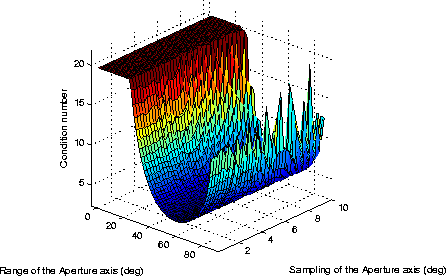Figure 2 displays the condition number values for Taylor Sand as a function of the sampling range and the sampling interval of the aperture-angle axis. It illustrates that the sampling interval of the aperture-angle axis has no impact on the condition number. Because we estimate only two parameters, increasing the sampling interval of the aperture-angle axis only adds redundant constraints to our inversion problem. However, when taking into account noise in the data, the shorter the sampling interval, the most robust the estimation of the anisotropic parameters. This could be mathematically demonstrated by looking at the variance of the forward modeling matrix.
Furthermore, the figure illustrates that there exists an optimal range for the aperture-angle axis. In
the given example, the minimum condition number is reached for an aperture range of around
![]() . When the aperture range is too small, the condition number takes extreme values (it has
to be noticed that in figure 2, we had to threshold condition numbers higher than 20). The
problem is ill-conditioned because the anisotropic parameter VH can only be estimated from
large-aperture data and is consequently poorly resolved. Conversely, when the aperture range
is too large, the condition number also takes extreme values. This is because the anisotropic
parameter VN is not accurately resolved: actually, by solving the inverse problem, we
minimize the cost function
. When the aperture range is too small, the condition number takes extreme values (it has
to be noticed that in figure 2, we had to threshold condition numbers higher than 20). The
problem is ill-conditioned because the anisotropic parameter VH can only be estimated from
large-aperture data and is consequently poorly resolved. Conversely, when the aperture range
is too large, the condition number also takes extreme values. This is because the anisotropic
parameter VN is not accurately resolved: actually, by solving the inverse problem, we
minimize the cost function ![]() ,and because this cost function can take much larger
values at large aperture angles than at small ones (RMO increases with aperture angle),
inverting large-aperture data is equivalent to inverting large-aperture angle data only, i.e.
constraining VH only. The poor constraints on VN explain why the condition number takes
extreme values for large-aperture data.
,and because this cost function can take much larger
values at large aperture angles than at small ones (RMO increases with aperture angle),
inverting large-aperture data is equivalent to inverting large-aperture angle data only, i.e.
constraining VH only. The poor constraints on VN explain why the condition number takes
extreme values for large-aperture data.
|
Condition1
Figure 2 Sensitivity of the condition number to the range and sampling of the aperture-angle axis (condition numbers higher than 20 have been thresholded). |  |